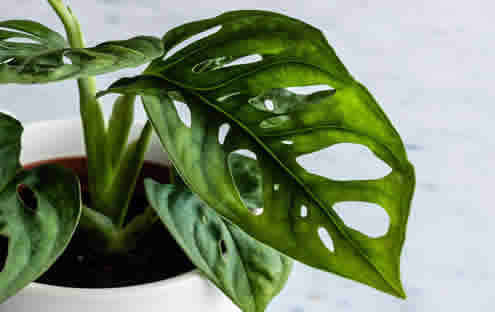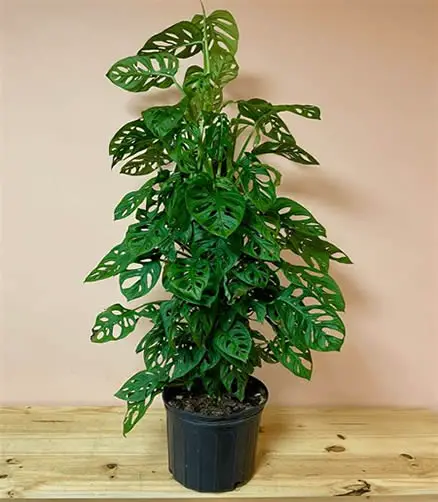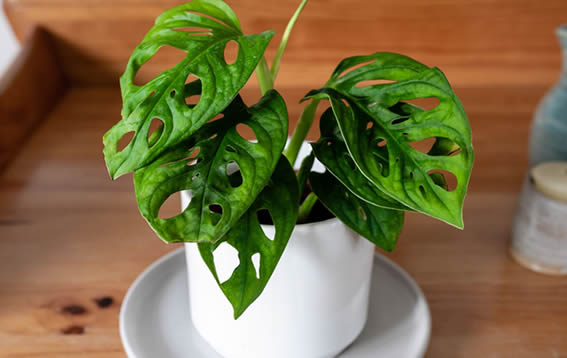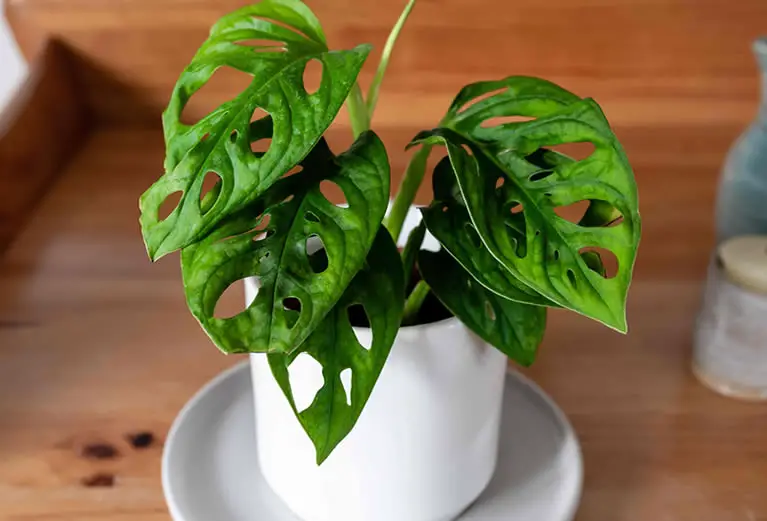The Swiss Cheese Plant (Monstera adansonii) is an eye-catching tropical houseplant known for its dramatic, hole-filled leaves. Its foliage has a wild, jungle-like feel that adds character to any space, and its easy-going care needs make it just as lovable as its cousin Monstera deliciosa—but with even more attitude.
Whether you let it climb, trail, or sprawl, this plant brings a lot of charm for very little effort.
Table of Contents
- Monstera adansonii
- Light Needs: Bright and Indirect Is Best
- Watering: Consistent, Not Constant
- Humidity and Temperature: Tropical Comforts Only
- Fertilizer: Feed for Healthy Growth and Fuller Leaves
- Soil and Repotting: Loose and Well-Draining Is Key
- Pruning and Training: Keep It Tidy or Let It Climb
- Best Spot in the Home: Let It Trail or Climb in Style
- Outdoor Care: Warm Weather Welcome
- Common Problems and Fixes
- Final Thoughts
Monstera adansonii
Native to the rainforests of Central and South America, Monstera adansonii grows as a climbing vine in the wild, attaching itself to trees and scaling toward the light.
It’s part of the Araceae family and is often called the Swiss Cheese Vine due to the large fenestrations (holes) in its leaves.

This fast-growing species is more compact and vining than Monstera deliciosa, making it perfect for hanging baskets, plant shelves, or as a climber on a moss pole.
The holes in the leaves help the plant withstand wind in its native habitat and allow sunlight to reach the lower leaves.
Light Needs: Bright and Indirect Is Best
Swiss Cheese Plants prefer bright, indirect light.
They can tolerate lower light levels, but too little light can lead to leggy growth and fewer fenestrations.
Direct sun can scorch the leaves, so filtered light through a sheer curtain works best.
If you’re growing it on a trellis or pole, give it access to the brightest spot you can without harsh rays.
Watering: Consistent, Not Constant
Water when the top 1–2 inches of soil feel dry.
This plant enjoys slightly moist soil, but it hates being soggy.

Let the excess water drain completely, and avoid letting the plant sit in water.
In winter, allow the soil to dry out a bit more between waterings.
Use distilled or filtered water if your tap water is high in salts or chlorine.
Humidity and Temperature: Tropical Comforts Only
Monstera adansonii thrives in humidity levels of 60% or higher.
Average indoor humidity is usually fine, but the plant will reward you with faster growth and larger leaves in more humid conditions.
Aim for temperatures between 65°F and 85°F, and avoid drafts or cold air.
Place it near a humidifier, on a pebble tray, or group it with other tropical plants to raise humidity naturally.
Fertilizer: Feed for Healthy Growth and Fuller Leaves
Feed every 4–6 weeks during the growing season with a balanced liquid houseplant fertilizer.
Look for something with an NPK ratio of 20-20-20 this one, or 10-10-10 this one, diluted to half strength.
Don’t fertilize in winter when growth naturally slows.
Overfeeding can cause salt buildup and leaf damage, so less is more.
Soil and Repotting: Loose and Well-Draining Is Key
Use a chunky, well-draining potting mix—ideally something designed for aroids.
A mix of potting soil, orchid bark, perlite, and coco coir works beautifully.

Repot every 1–2 years or when you see roots circling the pot.
Do this in spring or early summer.
Choose a pot with drainage holes to prevent overwatering and rot.
Pruning and Training: Keep It Tidy or Let It Climb
Prune as needed to control size or encourage bushier growth.
Snip just above a leaf node using clean scissors or pruning shears.
You can train your plant to climb using a moss pole or let it trail from a shelf or hanging basket.
Remove any yellow, leggy, or damaged stems to keep it healthy and full.
Consider using your cuttings to grow new plants as outlined in our article How to Propagate Monstera adansonii (Swiss Cheese Plant).
Best Spot in the Home: Let It Trail or Climb in Style
The Swiss Cheese Plant is perfect for living rooms, bedrooms, or home offices where it can climb a pole or drape from a shelf.

Just make sure it’s close to bright, filtered light and out of the way of drafts or heat vents.
If it’s trailing, a plant hanger near a window works beautifully.
Outdoor Care: Warm Weather Welcome
In USDA zones 10–12, Monstera adansonii can be grown outdoors year-round in dappled shade.
In cooler climates, it can spend spring and summer on a shady patio or balcony.
Be sure to bring it indoors once nighttime temperatures drop below 60°F.
Keep it out of strong sun, and monitor watering more closely outdoors where soil dries faster.
Common Problems and Fixes
Yellowing leaves often mean overwatering or poor drainage
Fix it by letting the soil dry more between waterings and checking your pot’s drainage
Brown leaf tips may be from dry air or underwatering
Fix it by increasing humidity and watering more consistently

No fenestrations in new leaves usually means the plant isn’t getting enough light
Fix it by moving your Monstera to a brighter location
Leggy growth happens when the plant is reaching for light
Fix it by trimming back and offering a moss pole or trellis near a bright window
Drooping leaves can be a sign of thirst or shock
Fix it by checking soil moisture and adjusting light or humidity if the plant was recently moved
Final Thoughts
The Swiss Cheese Plant is easy to love and even easier to grow.
With its dramatic foliage, vining nature, and flexible style—climbing or trailing—it adds instant depth to any plant collection.
Give it light, humidity, and a bit of structure, and it will reward you with wild, lacy leaves that make your home feel like a slice of the tropics.

